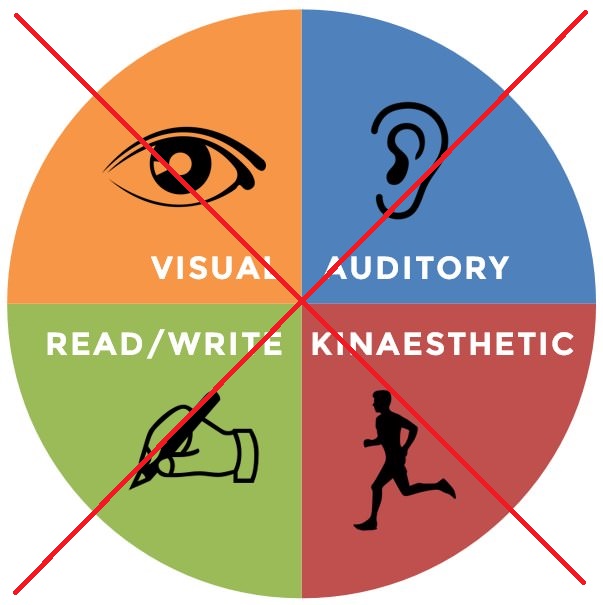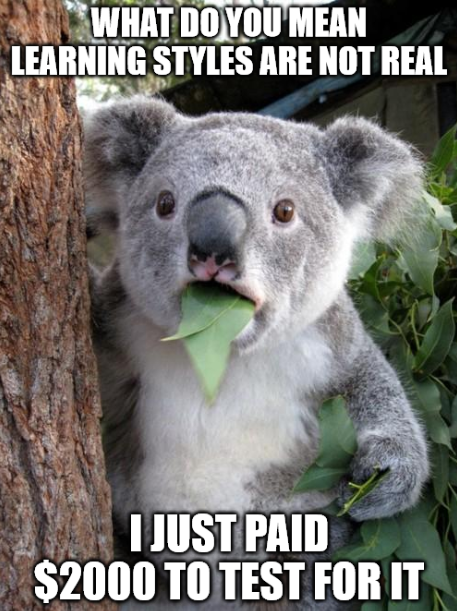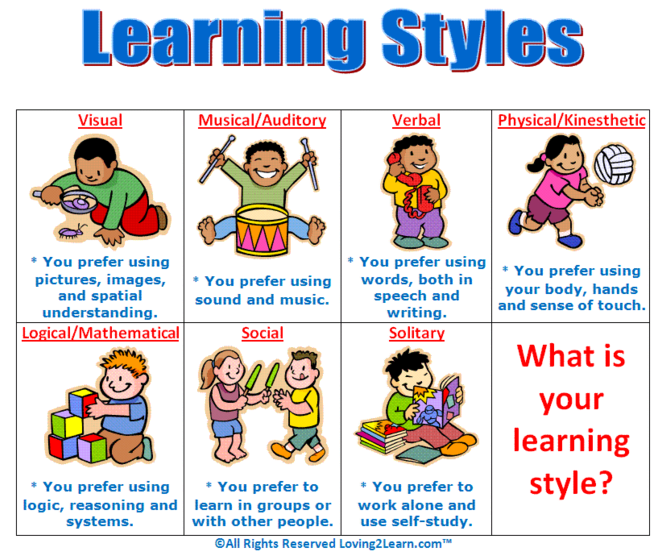Learning Styles as a Myth: Some Evidence from Books

This article is my curated list of evidence gathered throughout the years. If you want further evidence and explanations, read on.
It’s become an axiom that “everyone learns differently.” So learning styles are the logical next step, right? Not really.
What are learning styles?
The underlying premise [of learning styles] says that people receive and process new information differently: for example, some learn better from visual materials, and others learn better from written text or auditory materials. Make It Stick
From Why Don’t Students Like School?:
The visual-auditory-kinesthesia theory holds that everyone can take in new information through any of the three senses, but most of us have a preferred sense. When learning something new, visual types like to see diagrams, or even just to see in print the words that the teacher is saying. Auditory types prefer descriptions, usually verbal, to which they can listen. Kinesthetic learners like to manipulate objects physically; they move their bodies in order to learn.
It is true that some people have especially good visual or auditory memories. In that sense there are visual learners and auditory learners. But that’s not the key prediction of the theory. The key prediction is that students will learn better when instruction matches their cognitive style. That is, suppose Anne is an auditory learner and Victor is a visual learner. Suppose further that I give Anne and Victor two lists of new vocabulary words to learn. To learn the first list, they listen to a tape of the words and definitions several times; to learn the second list, they view a slide show of pictures depicting the words. The theory predicts that Anne should learn more words on the first list than on the second whereas Victor should learn more words on the second list than on the first.
How many people believe in learning styles?
While there’s no research supporting the notion of learning styles—the idea that someone learns better kinesthetically or visually—more than 80 percent of the public believe that learning styles exist. Learn Better
The idea that individuals have distinct learning styles has been around long enough to become part of the folklore of educational practice and an integral part of how many people perceive themselves. […] Belief in the learning styles credo is pervasive. Assessing students' learning styles has been recommended at all levels of education, and teachers are urged to offer classroom material in many different ways so that each student can take it in the way he or she is best equipped to learn it. Make It Stick
Many years ago I came across a book about improving one’s memory. There was a test to determine one’s learning styles. It goes something like this: read a paragraph by yourself, then have someone read to you another paragraph (i.e. listening to it). Take a comprehension test for both paragraphs, calculate the scores to see whether you’re a visual or auditory learner.
“What is your learning style?”
“SuperMemo style.”
A nail in the coffin for learning styles
In 2008 the cognitive psychologists Harold Pashler, Mark McDaniel, Doug Rohrer, and Bob Bjork were commissioned to conduct a review to determine whether this critical claim [that learning styles] is supported by scientific evidence.
Initially, students must be divided into groups according to their learning styles. Then they must be randomly assigned to different classrooms teaching the same material but offering it through different instructional methods. Afterward, all the students must take the same test. The test must show that students with a particular learning style (e.g., visual learners) did the best when they received instruction in their own learning style (visual) relative to instruction in a different style (auditory); in addition, the other types of learners must be shown to profit more from their style of instruction than another style (auditory learners learning better from auditory than from visual presentation).
The team asked whether this kind of evidence existed. The answer was no. They found very few studies designed to be capable of testing the validity of learning styles theory in education, and of those, they found that virtually none validate it and several flatly contradict it.
From overview studies of empirical studies of the effects of learning style on learning, it appears that matching subject matter to learning style actually doesn’t lead to better learning. If better learning was the case, pupils with an auditory learning style, for example, would learn better if allowed to listen to the instruction and less well or not at all if they had to read the instruction. There has been a frantic search in the literature to confirm this interaction, but unfortunately none has been found.
What matters if learning styles don’t?
Moreover, their review showed that it is more important that the mode of instruction match the nature of the subject being taught: visual instruction for geometry and geography, verbal instruction for poetry, and so on. When instructional style matches the nature of the content, all learners learn better, regardless of their differing preferences for how the material is taught. Make It Stick
A final problem becomes clear with the following question: How do you explain to a pupil in an auditory way how crimson red and brick red look? Or how do you kinaesthetically explain how a blackbird sings? In other words, it’s actually the subject matter and the learning goal that should determine how one teaches and not a preference or a non-existent learning style. How Learning Happens
Do not fall for this learning styles scam
A report […] compares more than seventy distinct learning styles theories currently being offered in the marketplace, each with its companion assessment instruments to diagnose a person’s particular style. The report’s authors characterize the purveyors of these instruments as an industry bedeviled by vested interests that tout “a bedlam of contradictory claims” and express concerns about the temptation to classify, label, and stereotype individuals.
The authors relate an incident at a conference where a student who had completed an assessment instrument reported back: “I learned that I was a low auditory, kinesthetic learner. So there’s no point in me reading a book or listening to anyone for more than a few minutes.” The wrongheadedness of this conclusion is manifold. It’s not supported by science, and it instills a corrosive, misguided sense of diminished potential. Make It Stick
I remember seeing a documentary about learning styles. There are companies selling “discover your child’s learning style” toolkit. This toolkit includes a “highly personalized” report with “genetic testing to find what career is more suitable for your child”. There were many parents happy to fork out $2000 for it.

Conclusion
I’ll never do a better job than those quoted authors explaining why learning styles are a scam. I hope I’ve provided you with enough evidence to convince you that learning styles are not real.
